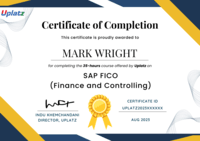Career Path - AI Ethics and Governance Specialist
Master the principles of AI ethics, compliance, governance, and risk to build responsible and trustworthy AI systems.Preview Career Path - AI Ethics and Governance Specialist course
Price Match Guarantee Full Lifetime Access Access on any Device Technical Support Secure Checkout Course Completion Certificate 93% Started a new career
BUY THIS COURSE (GBP 99)
93% Started a new career
BUY THIS COURSE (GBP 99)
-
 87% Got a pay increase and promotion
87% Got a pay increase and promotion
Students also bought -
-

- Career Accelerator - Head of Data, Analytics, and Machine Learning
- 200 Hours
- GBP 32
- 650 Learners
-

- Career Path - Business Intelligence Analyst
- 200 Hours
- GBP 99
- 679 Learners
-

- Internet of Things (IoT) Basics
- 10 Hours
- GBP 12
- 98 Learners

- Follow the Sequence: Each module builds on the previous. Avoid skipping ahead.
- Engage in Case Studies: Real-world scenarios are presented for practical reflection and analysis.
- Use Provided Checklists and Templates: These tools will help you apply what you learn in your workplace or projects.
- Stay Updated: AI ethics is an evolving field. The course includes resources to track emerging regulations and best practices.
- Join Discussions and Forums: Collaboration with peers will deepen your understanding of diverse perspectives and global ethical challenges.
Course/Topic 1 - Course access through Google Drive
-
Google Drive
-
Google Drive
Course/Topic 2 - Data Science with R - all lectures
-
In this lecture session we learn about introduction of data science and also talk about features of data science in R.
-
In this lecture session we learn about data collection and management and also talk about features of data collection and management in data science with R.
-
In this lecture session we learn about model deployment and maintenance and also talk about functions of model deployment and maintenance in data science with R.
-
In this lecture session we learn about setting expectations and also talk about factors of setting expectations in brief.
-
In this lecture session we learn about loading data into R and also talk about features of loading data into R and also talk about the importance of loading data into R.
-
In this lecture session we learn about exploring data in data science and machine learning and also talk about features of exploring data in data science and machine learning.
-
In this lecture session we learn about features of exploring data using R and also talk about factors of exploring data using R.
-
In this lecture session we learn about benefits of data cleaning and also talk about features of benefits of data cleaning.
-
In this lecture session we learn about cross validation in R and also talk about features of validation in data science with R.
-
In these lecture sessions we learn about data transformation in data science with R and also talk about features of data transformation in brief.
-
In this lecture session we learn about modeling methods in data science with R and also talk about the importance of modeling methods.
-
In this lecture session we learn about solving classification problems and also talk about features of solving classification problems in brief.
-
In this lecture session we learn about working without known targets in data science with r and also talk about features of working without known targets.
-
In this lecture session we learn about evaluating models in data science with R and also talk about features of evaluating models in brief.
-
In this lecture session we learn about confusion matrix in indian accounting standards and also talk about features of confusion matrix.
-
In this lecture session we learn about introduction to linear regression and also talk about features of linear regression in indian accounting standards.
-
In this lecture session we learn about linear regression in R and also talk about features and functions of linear regression in brief.
-
In this lecture session we learn about linear regression in R in data science with r and also talk about features of linear regression in R language.
-
In this lecture session we learn about simple and multiple regression in data science with r and also talk about the basic difference between simple and multiple regression in brief.
-
In this lecture session we learn about linear and logistic regression in data science with r language and also talk about functions of linear and logistics regressions.
-
In this lecture session we learn about support vector machines (SVM) in R and also talk about features of support vector machines in data science with R language.
-
In this lecture session we learn about factors of support vectors machines in data science with R and also talk about features of support vectors machines.
-
In this lecture session we learn about unsupervised methods in data science with R and also talk about functions of unsupervised methods in data science.
-
In this lecture session we learn about clustering in data science with R language and also talk about features of clustering in data science.
-
In this lecture session we learn about K-means algorithms in R and also talk about all types of algorithms in data science with R language.
-
In this lecture session we learn about hierarchical clustering in data science with R language and also talk about features of hierarchical clustering.
-
In this lecture session we learn about libraries in data science with R and also talk about libraries of hierarchical clustering in brief.
-
In this lecture session we learn about the dendrogram of diana and also talk about all types of clustering in data science with R.
-
In this lecture session we learn about market basket analysis in data science with R and also talk about features of market basket analysis in data science with R.
-
In this lecture session we learn about MBA and association rule mining in data science with r language.
-
In this lecture session we learn about implementing MBA in data science with R and also talk about implementing MBA.
-
In this lecture session we learn about association rule learning in data science with R and also talk about features of association rule learning.
-
In this lecture session we learn about decision tree algorithms in data science with R and also talk about features of tree algorithms.
-
In this lecture session we learn about exploring advanced methods in tree algorithms in data science with R and also talk about features of exploring advanced methods.
-
In this lecture session we learn about using kernel methods and also talk about features of using kernel methods in data science with R.
-
In this lecture session we learn about documentation and deployment and also talk about features of documentation and deployment in data science with R.
By the end of this course, learners will be able to:
- Understand core AI ethics principles including fairness, accountability, and transparency.
- Identify ethical risks and apply mitigation strategies throughout the AI lifecycle.
- Evaluate compliance requirements such as GDPR, AI Act, and algorithmic audits.
- Design AI governance frameworks aligned with international best practices.
- Assess and reduce algorithmic bias in machine learning systems.
- Apply ethical impact assessments for AI systems.
- Create Responsible AI policies and documentation.
- Interpret regulatory frameworks and navigate global AI policy landscapes.
- Promote diversity and inclusion in AI development teams.
- Lead cross-functional discussions on AI trust, safety, and social impact.
– Definition, scope, and need for AI ethics
– Evolution of ethical AI frameworks
– Fairness, Accountability, Transparency
– Explainability and Interpretability
– Privacy and Consent
– Risk Identification in ML pipelines
– Risk Assessment Models (ISO, NIST)
– Mitigation Tools
– Types of bias: historical, sampling, measurement
– Fairness metrics and audits
– Case studies in healthcare, finance
– UNESCO, OECD, IEEE standards
– AI Governance Models (centralized vs. decentralized)
– Impact on corporate policies
– Overview of GDPR, AI Act (EU), U.S. Executive Orders
– Regulatory compliance and documentation
– Ethical impact assessments
– Designing AI with ethics-by-design
– Responsible AI toolkits (Microsoft, IBM, Google)
– Cross-functional governance committees
– Lifecycle ethical review
– Procurement and vendor oversight
– Incident response for ethical breaches
– Audit templates and checklists
– Audit trails and explainability logs
– Aligning with industry certifications
– Real-world case studies (facial recognition, hiring algorithms)
– Design a Responsible AI framework for a selected organization
- AI Ethics Consultant
- Responsible AI Officer
- Governance and Risk Analyst
- AI Policy Advisor
- Compliance and Audit Lead (AI)
- Ethical AI Product Manager
- AI Strategy and Innovation Manager
AI Ethics refers to the principles and values guiding the development and use of AI. It's important to prevent harm, ensure fairness, and maintain public trust.
The main principles include fairness, accountability, transparency, privacy, and explainability.
By auditing data inputs, evaluating model outputs across demographics, and using fairness metrics such as demographic parity or equal opportunity.
Governance refers to internal frameworks for managing AI responsibly, while compliance ensures adherence to external laws and regulations.
GDPR mandates data minimization, user consent, and transparency, especially for automated decision-making.
It’s a structured approach to designing, building, and deploying AI systems with ethical safeguards, accountability measures, and continuous oversight.
It’s a process for evaluating the potential societal, ethical, and legal impacts of an AI system before deployment.
Microsoft Responsible AI dashboard, IBM AI Fairness 360, Google What-If Tool.
Transparency enables users and regulators to understand how AI systems make decisions, fostering trust and accountability.
Through periodic audits, AI ethics committees, impact assessments, and alignment with evolving legal standards.









